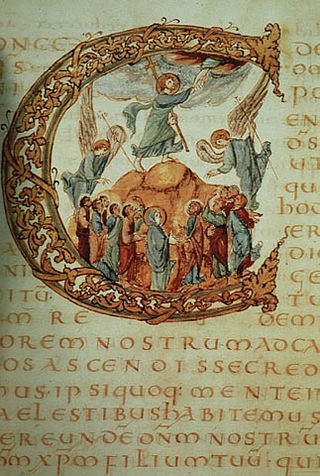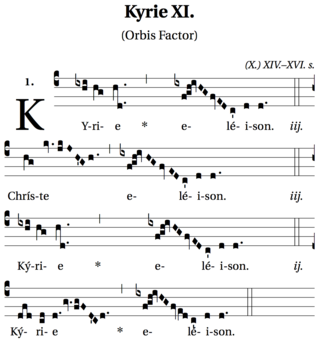Related Research Articles

The Liber Pontificalis is a book of biographies of popes from Saint Peter until the 15th century. The original publication of the Liber Pontificalis stopped with Pope Adrian II (867–872) or Pope Stephen V (885–891), but it was later supplemented in a different style until Pope Eugene IV (1431–1447) and then Pope Pius II (1458–1464). Although quoted virtually uncritically from the 8th to 18th centuries, the Liber Pontificalis has undergone intense modern scholarly scrutiny. The work of the French priest Louis Duchesne, and of others has highlighted some of the underlying redactional motivations of different sections, though such interests are so disparate and varied as to render improbable one popularizer's claim that it is an "unofficial instrument of pontifical propaganda."

In textual studies, a palimpsest is a manuscript page, either from a scroll or a book, from which the text has been scraped or washed off in preparation for reuse in the form of another document. Parchment was made of lamb, calf, or kid skin and was expensive and not readily available, so, in the interest of economy, a page was often re-used by scraping off the previous writing. In colloquial usage, the term palimpsest is also used in architecture, archaeology and geomorphology to denote an object made or worked upon for one purpose and later reused for another; for example, a monumental brass the reverse blank side of which has been re-engraved.

The Drogo Sacramentary is a Carolingian illuminated manuscript on vellum from c. 850 AD, one of the monuments of Carolingian book illumination. It is a sacramentary, a book containing all the prayers spoken by the officiating priest during the course of the year. In the Sacramentary, Christ is depicted as the central figure, holding the staff of Jacob as he accepts God’s hand and begins his ascension into the clouds, from which God's hand appears.
Low Mass is a Tridentine Mass defined officially in the Code of Rubrics included in the 1962 edition of the Roman Missal as a Mass in which the priest does not chant the parts that the rubrics assign to him. A sung Mass celebrated with the assistance of sacred ministers is a High or Solemn Mass; without them it is a Missa Cantata.

Kyrie, a transliteration of Greek Κύριε, vocative case of Κύριος (Kyrios), is a common name of an important prayer of Christian liturgy, also called the Kyrie eleison.
In the Western Church of the Early and High Middle Ages, a sacramentary was a book used for liturgical services and the mass by a bishop or priest. Sacramentaries include only the words spoken or sung by him, unlike the missals of later centuries that include all the texts of the mass whether read by the bishop, priest, or others. Also, sacramentaries, unlike missals, include texts for services other than the mass such as ordinations, the consecration of a church or altar, exorcisms, and blessings, all of which were later included in Pontificals and Rituals instead.

The so-called Gelasian Sacramentary is a book of Christian liturgy, containing the priest's part in celebrating the Eucharist. It is the second oldest western liturgical book that has survived: only the Verona Sacramentary is older.
The Gallican Rite is a historical form of Christian liturgy and other ritual practices in Western Christianity. It is not a single liturgical rite but rather several Latin liturgical rites that developed within the Latin Church, which comprised the majority use of most of Western Christianity for the greater part of the 1st millennium AD. The rites first developed in the early centuries as the Syriac-Greek rites of Jerusalem and Antioch and were first translated into Latin in various parts of the Western Roman Empire Praetorian prefecture of Gaul. By the 5th century, it was well established in the Roman civil diocese of Gaul, which had a few early centers of Christianity in the south. Ireland is also known to have had a form of this Gallican Liturgy mixed with Celtic customs.

The Roman Rite is the most common ritual family for performing the ecclesiastical services of the Latin Church, the largest of the sui iuris particular churches that comprise the Catholic Church. The Roman Rite governs rites such as the Roman Mass and the Liturgy of the Hours as well as the manner in which sacraments and blessings are performed.
Liber diurnus Romanorum pontificum is the name given to a miscellaneous collection of ecclesiastical formulae used in the Papal chancery until about the 11th century. It fell into disuse through the changed circumstances of the times and was soon forgotten and lost.

An antiphonary or antiphonal is one of the liturgical books intended for use in choro, and originally characterized, as its name implies, by the assignment to it principally of the antiphons used in various parts of the Latin liturgical rites.

The Codex Zouche-Nuttall or Codex Tonindeye is an accordion-folded pre-Columbian document of Mixtec pictography, now in the collections of the British Museum. It is one of about 16 manuscripts from Mexico that are entirely pre-Columbian in origin. The codex derives its name from Zelia Nuttall, who first published it in 1902, and Baroness Zouche, its donor.
The Roman Canon is the oldest eucharistic prayer used in the Mass of the Roman Rite, and dates its arrangement to at least the 7th century; its core, however, is much older. Through the centuries, the Roman Canon has undergone minor alterations and modifications, but retains the same essential form it took in the seventh century under Pope Gregory I. Before 1970, it was the only eucharistic prayer used in the Roman Missal, but since then three other eucharistic prayers were newly composed for the Mass of Paul VI.

The Codex Magliabechiano is a pictorial Aztec codex created during the mid-16th century, in the early Spanish colonial period. It is representative of a set of codices known collectively as the Magliabechiano Group. The Codex Magliabechiano is based on an earlier unknown codex, which is assumed to have been the prototype for the Magliabechiano Group. It is named after Antonio Magliabechi, a 17th-century Italian manuscript collector, and is held in the Biblioteca Nazionale Centrale, Florence, Italy.

Verona Cathedral is a Roman Catholic cathedral in Verona, northern Italy, dedicated to the Blessed Virgin Mary under the designation Santa Maria Matricolare. It is the episcopal seat of the Diocese of Verona.

Onofrio Panvinio or Onuphrius Panvinius O.S.A. was an Italian Augustinian friar, historian and antiquary who was the librarian to Cardinal Alessandro Farnese.

The Codex Laud, or Laudianus, is a sixteenth-century Mesoamerican codex named for William Laud, an English archbishop who was the former owner. It is from the Borgia Group, and is a pictorial manuscript consisting of 24 leaves from Central Mexico, dating from before the Spanish takeover. It is evidently incomplete.

Within the Roman Rite of the Catholic Church, a variety of liturgical books have been officially approved to contain the words to be recited and the actions to be performed in the celebration of Catholic liturgy. The Roman Rite of the Latin Church of the Catholic Church is the most widely used liturgical rite. The titles of some of these books contain the adjective "Roman", e.g. the Roman Missal, to distinguish them from the liturgical books for the other rites of the church.

The Bobbio Missal is a seventh-century Christian liturgical codex that probably originated in France.
Codex Veronensis is a 6th-century manuscript of the Psalter in Greek and Latin. The codex consists of 405 leaves, measuring 10½ x 7½ inches; each page contains 26 lines. The Greek text appears at each opening on the left-hand page, and the Latin on the right.
References
- ↑ F. L. Cross; E. A. Livingstone, eds. (2006), "Libelli Missarum", The Oxford Dictionary of the Christian Church (2nd rev. ed.), Oxford University Press.
- 1 2 F. L. Cross; E. A. Livingstone, eds. (2006), "Leonine Sacramentary", The Oxford Dictionary of the Christian Church (2nd rev. ed.), Oxford University Press.